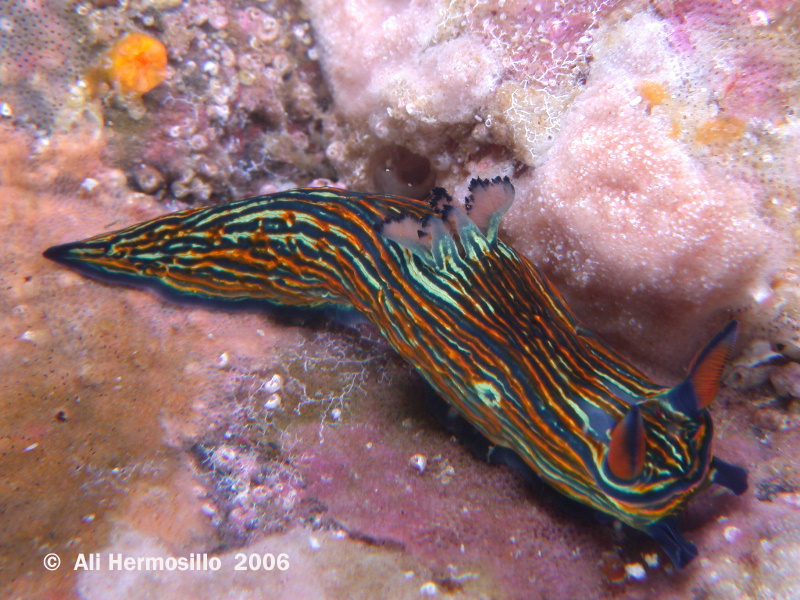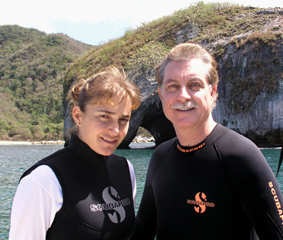 |
Roboastra leonis
Costa Rica
Photo courtesy of Ali Hermosillo
Roboastra leonis Pola, Cervera & Gosliner 2005
Long before Charles Darwin stepped off of the HMS Beagle, a large phanerobranch dorid voraciously foraged the waters of the Galapagos Archipelago. The name “leonis” was intended partially to draw attention to the species aggressive predatory habits, feeding on other polycerids such as Tambja mullineri .
Ali has captured an individual attaching a Tambja eliora in Costa Rica. In the first shot the R. leonis picks up the smell of the Tambja’s slime trail. The second shot records a successful kill by the Roboastra, who is swallowing its prey head first.
Referred to by guides in the Galapagos as “Nudibranchio Magnifico”, this newly named species is a real eye opener. Reaching 10 cm in length, the species is greenish in color with yellow stripes. The rhinophores are amber anteriorly and bluish black posteriorly. Just behind the rhinophores are two bright blue patches situated over the evolving optical nerve and eyes.
The species ranges from the Galapagos to the Gulf of California.
References:
Camacho-Garcia, Y., T.M. Gosliner and A. Valdes. 2005. Field Guide to the Sea Slugs of the Tropical Eastern Pacific. California Academy of Sciences. San Francisco, CA.
Debelius, H. 1998. Nudibranchs and Sea Snails, Indo-Pacific Field Guide. IKAN. Frankfurt, Germany.
Hickman, C.P. and Y. Finet. 1999. A field guide to Marine Molluscs of Galapagos. Sugar Spring Press, Lexington, VA.
Pola, M. J.L. Cervera and T.M. Gosliner. 2005. Review of the systematics of the genus Roboastra Bergh, 1877 (Nudibranchia, Polyceridae, Nembrothinae) with the description of a new species from the Galapagos Islands. Zool. Journ Linnean Soc. 144: 167-189.
Gig Harbor, Washington
June 2006
Webmaster's Notes:
Nature always seems to have the last say in the putting these presentations together. Winfried Werzmirzowsky of Germany was kind enough to send a CD of images from a recent Galapagos trip. The image of special interest to sea slug fans was that of Roboastra leonis with a decidedly different coloration than it's Caribbean cousins. Winfried and I wrestled with the issue of color rendition during digital scanning and subsequent CD burning but finally decided that what one sees is the reality of the animal. The film image was also taken with a Nikon RS, probably one of the best film U/W systems ever produced (Photographer behind the camera isn't bad either). Finally, we decided that, hey, that's way it is!
San Diego, California
June 2006
March 2005

Ali Hermosillo and Dave Behrens
Author:
Pacific Coast Nudibranchs
Send Dave mail at dave@seachallengers.com
|
